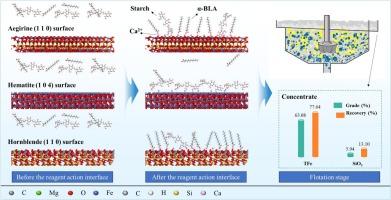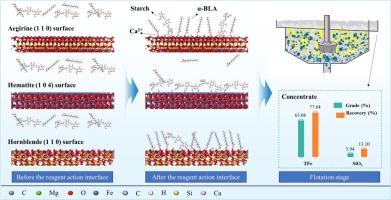新型捕收剂对含铁硅酸盐矿物与赤铁矿的选择性分离:表面相互作用机理研究
IF 6.9
2区 材料科学
Q2 CHEMISTRY, PHYSICAL
引用次数: 0
摘要
研究了α-溴金酸(α-BLA)作为一种新型捕收剂,用于赤铁矿与含铁硅酸盐矿物(角闪石和铁镁)的反浮选分离。通过微浮选试验、性能量化、接触角测量、zeta电位分析、FTIR和XPS光谱分析,系统分析了浮选性能及其机理。性能量化证实α-BLA具有“Top”的收集能力,但选择性有限,需要淀粉作为抑制剂。在最佳条件下(pH = 11, α-BLA = 57.2 mg/L, CaCl2 = 25.75 mg/L),总铁品位和回收率分别达到63.08 %和77.64 %,SiO2含量降至5.40 %。矿物表面的铁位点密度对试剂吸附至关重要,因为α-BLA和淀粉都通过这些位点结合。即使经过淀粉处理,α-BLA仍选择性吸附在角闪石和硫胺上,有效调节浮选界面。在气泡-矿物界面,疏水吸引、亲水排斥和静电相互作用控制着气泡的附着,从而实现了有效的矿物分离。本研究介绍了α-BLA作为一种很有前途的铁矿反浮选工业捕收剂,并为开发高性能浮选药剂提供了机理见解。本文章由计算机程序翻译,如有差异,请以英文原文为准。


Selective separation of iron-bearing silicate minerals from hematite via a novel collector: surface interaction mechanistic investigation
This study evaluates α-bromolauric acid (α-BLA) as a novel collector for the reverse flotation separation of hematite from iron-bearing silicate minerals (hornblende and aegirine). Flotation performance and underlying mechanisms were systematically analyzed through micro-flotation tests, performance quantification, contact angle measurements, zeta potential analysis, FTIR, and XPS spectroscopy. Performance quantification confirmed that α-BLA exhibits “Top” collecting ability but limited selectivity, necessitating starch as a depressant. Under optimal conditions (pH = 11, α-BLA = 57.2 mg/L, CaCl2 = 25.75 mg/L), total iron grade and recovery reached 63.08 % and 77.64 %, respectively, while SiO2 content decreased to 5.40 %. The iron site density on mineral surfaces is critical for reagent adsorption, as both α-BLA and starch bind via these sites. Even after starch treatment, α-BLA selectively adsorbs onto hornblende and aegirine, effectively regulating flotation interfaces. At the bubble–mineral interface, hydrophobic attraction, hydrophilic repulsion, and electrostatic interactions govern bubble attachment, enabling efficient mineral separation. This study introduces α-BLA as a promising industrial collector for iron ore reverse flotation and offers mechanistic insights for developing high-performance flotation reagents.
求助全文
通过发布文献求助,成功后即可免费获取论文全文。
去求助
来源期刊

Applied Surface Science
工程技术-材料科学:膜
CiteScore
12.50
自引率
7.50%
发文量
3393
审稿时长
67 days
期刊介绍:
Applied Surface Science covers topics contributing to a better understanding of surfaces, interfaces, nanostructures and their applications. The journal is concerned with scientific research on the atomic and molecular level of material properties determined with specific surface analytical techniques and/or computational methods, as well as the processing of such structures.
 求助内容:
求助内容: 应助结果提醒方式:
应助结果提醒方式:


